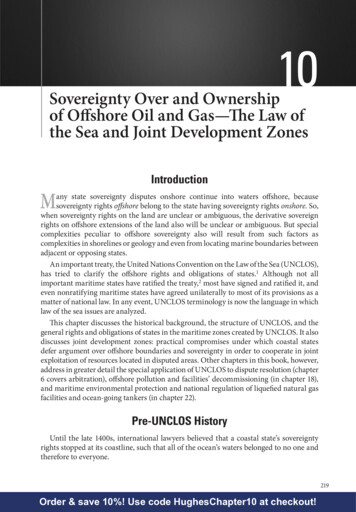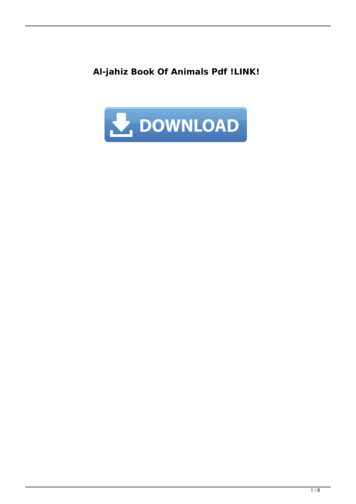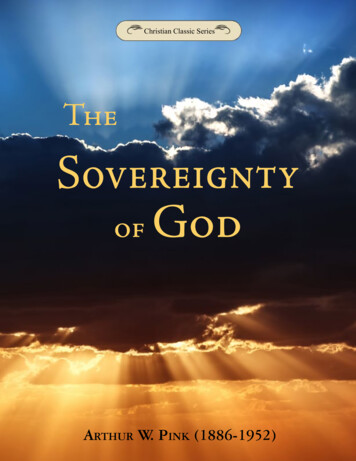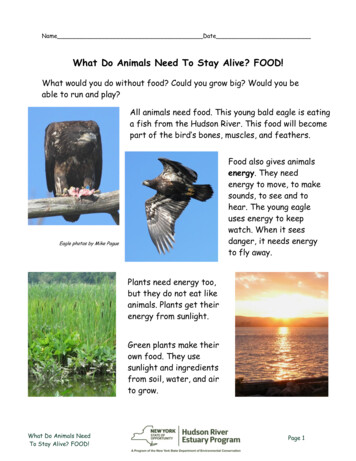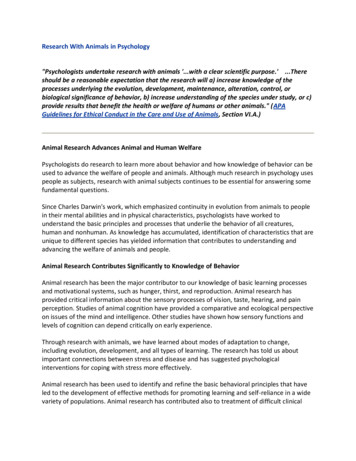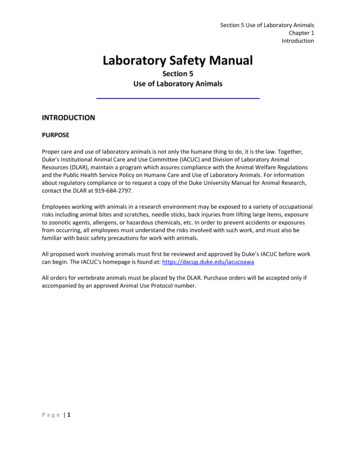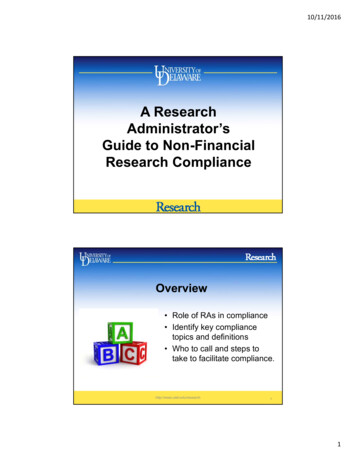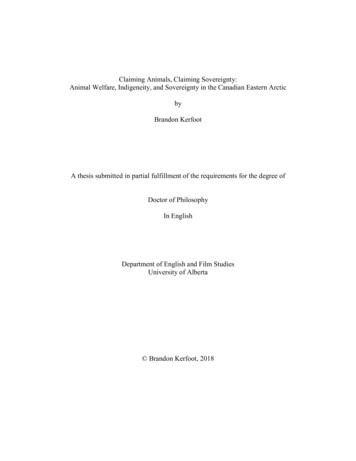
Transcription
Claiming Animals, Claiming Sovereignty:Animal Welfare, Indigeneity, and Sovereignty in the Canadian Eastern ArcticbyBrandon KerfootA thesis submitted in partial fulfillment of the requirements for the degree ofDoctor of PhilosophyIn EnglishDepartment of English and Film StudiesUniversity of Alberta Brandon Kerfoot, 2018
iiAbstractThis dissertation examines a series of case studies in the politics and semiotics of animal welfare,Indigeneity, and sovereignty in the Canadian Eastern Arctic from 1950 to 2017. Arctic animalssuch as seals, sled dogs, wolves, and polar bears often become the focus of Canadian animalwelfare activism, fundraising, and policy, a focus that quickly becomes conflict, for theseanimals are central to Inuit hunting and social relations, whereas many Southern Canadians havenever encountered them. Drawing on Frank Tester and Peter Kulchyski’s analysis of thetwentieth-century welfare state and animal management in Tammarniit (Mistakes) and Kiumajut(Talking Back) respectively, I argue that in contemporary literature and politics, variouspoliticized groups make covert sovereignty claims as they assert kinship with arctic animals.This research exposes the animal welfare state, which formed in the late twentieth century tocircumvent Indigenous activism and continue colonial policies under the guise of concern foranimals.This project defines and analyzes the appropriated meanings that sustain the animalwelfare state. Deploying Roland Barthes’ analysis of myth, I develop a semiotic framework thataddresses the movements and barriers between Inuit speculative fiction, environmental andanimal welfare activism, and political documents, and I contribute to the fields of critical animalstudies and Indigenous literary studies by identifying the common structure by which seeminglydisparate groups make legitimacy claims. By exposing the mechanics and pressure points of theanimal welfare state’s mythological structure, I also show how its apparent resilience belies adeep instability and vulnerability.
iiiAcknowledgementsI am fortunate to have received multifaceted support in the course of writing this dissertation. Iam grateful to my supervisor, Dr. Karyn Ball, and my readers, Dr. Christopher Bracken and Dr.Keavy Martin, whose combination of expertise and styles of critique have been invaluable.Karyn’s attention to textual detail and argumentative nuance has trained me to be a more carefulreader, and her near-mythical sense of when to let me work through difficulties and when to stepin has been integral to this project’s success and to my development as a scholar. I am grateful toChristopher both for his incisive criticisms and for his varied modes of delivering them, whichhas made complacency impossible and has exposed the clichés that I inhabit. I thank Keavy forguiding me out of a comfort zone too small for this project and for challenging me when I triedto cleave the scholar from other facets of my person. My externals, Dr. Kim TallBear and Dr.Margery Fee, have helped to reshape the project in its later stage. Kim’s questions and criticismsduring the defense immediately reoriented my relationship with the texts in ways that willcertainly show in this project’s next form, and Margery’s editorial comments go beyond theduties of an external and have made this dissertation more precise.There are many brilliant and compassionate scholars in the Department of English andFilm Studies who were not directly involved in this dissertation but who have taught me much byway of example. I hope they will not object to my considering them mentors: Drs. CecilyDevereux, Corrine Harol, Natasha Hurley, Sarah Krotz, and Julie Rak. Marcelle Kosman and Dr.Hannah McGregor’s public scholarship is a continuing lesson in research that is collaborativeand responsible to its audiences and communities, and Katherine Meloche has been an invaluablefriend and colleague, always ready to recommend new texts and to challenge flimsy arguments.
ivI am grateful to Dr. Erin Julian, my cherished friend, for whom half a continent doesnothing to prevent ongoing company, collegiality, and support. Thank you especially forprompting me to read more widely and for filling my cat void with polar bear crochet: Lucy wasa wonderful dissertation mascot. The Making Waves Aquatics Club has diminished the periodsof isolation that frequently accompany long research projects. I am grateful to my friends andteammates for all the practices, competitions, and social events where nobody quoted Foucault. Ithank my parents, Colleen Kerfoot and Dale Kerfoot, for their unwavering support, for somehowknowing before I did that I would write something of this dissertation’s scope, and for inscribingthis knowledge in me when I was still sounding out words (and very indignant that “Mr.” readsas “mister,” when clearly there aren’t enough letters in the word to represent such a sound).This project would not have been possible without food and shelter, and for these I amgrateful to the many funders of this research. I thank the Department of English and Film Studiesfor its financial supports and award nominations in the form of teaching jobs, the DoctoralRecruitment Scholarship, Queen Elizabeth II Doctoral Scholarship, President’s Doctoral Prize ofDistinction, and Sarah Nettie Christie Travel Bursaries. I thank the Faculty of Graduate Studiesand Research for Graduate Travel Funds, and the Canadian Circumpolar Institute and the Ashleyand Janet Cameron Travel Fund. Finally, I thank the Social Sciences and Humanities ResearchCouncil for awarding me a Doctoral Fellowship.
vTable of ContentsIntroduction: The Animal Welfare State . 1The Animal Welfare State and Arctic Sovereignty . . 16Land-based Sovereignty and Divine Sovereignty .28Chapter Summary . .42Chapter 1: Writing Nuliajuk, the Mother of Sea Beasts: Land, Sovereignty, and Literature .46Writing Nuliajuk: Sexual Violence and Sovereignty .52Narrative Sovereignty and the Limits of Transformation 66Chapter 2: Slaughtering Dogs and Saving Wolves: The Rise of the Animal Welfare State .78The Dog Slaughter in Context .79Naming Sled Dogs: The Strategic Ambivalence of the Animal Sign .84From the Welfare State to the Animal Welfare State .95Dangerous Indigeneity and Euro-Settler Heteronormativity in Farley Mowat'sNever Cry Wolf.102Conclusion: Animal Welfare and the Politics of Concern .115Chapter 3: Powerful and Vulnerable Polar Bears: The Animal Welfare State as Land-basedSovereignty. .118Anecdote in Qapirangajuq: Inuit Knowledge and Climate Change .123The Vulnerable Polar Bear in BBC's Planet Earth and Frozen Planet .138The Polar Bear as Synecdoche for the Perilous Arctic .152Conclusion: An Anecdote .158Chapter 4: Hunting Seals: Criticism as Kinship in Anti-Sealing Literature .166Anti-Sealing: History and Context . .169Adoption Narratives: Disgust and Savagery in Anti-Sealing Campaigns .173Animal Welfare and the Soul .191Animals, Souls, and Vengeance: Seal Killers and Killer Seals in Alootook Ipellie’s ArcticDreams and Nightmares . 195Conclusion: Anger and Criticism .210Conclusion: Arctic Place-Making . .217Works Cited .223
viList of FiguresFigure 1: Alootook Ipellie, “Summit with Sedna, the Mother of Sea Beasts”Figure 2: Jeremy Mohler, “Nuliajuk”Figure 3: World Wildlife Foundation, “Would You Care More If I Was a Panda?”Figure 4: World Wildlife Foundation, “Would You Care More If I Was a Gorilla?”Figure 5: Alootook Ipellie, “After Brigitte Bardot”Figure 6: Alootook Ipellie, “Survival of the Most Violent”
1IntroductionThe Animal Welfare StateThis dissertation examines a series of case studies in the intersecting politics and semiotics ofanimal welfare, indigeneity, and sovereignty in the Canadian Eastern Arctic from 1950 to 2017. 1Arctic animals such as seals, sled dogs, wolves, and polar bears often become the focus ofCanadian animal welfare activism, fundraising, and policy, a focus that quickly becomesconflict, for these animals are central to Inuit hunting and social relations, whereas manySouthern Canadians have never encountered them. Drawing on Frank Tester and PeterKulchyski’s analysis of the twentieth-century welfare state and animal management inTammarniit (Mistakes) and Kiumajut (Talking Back) respectively, I argue that in contemporaryliterature and politics, various politicized groups make covert sovereignty claims as they assertkinship with arctic animals, collecting comprising the animal welfare state, which formed in thelate twentieth century to circumvent Indigenous activism and continue colonial policies under theguise of concern for animals.This project also defines and analyzes the appropriated meanings that sustain the animalwelfare state. Deploying Roland Barthes’ analysis of myth, I develop a semiotic framework thataddresses the movements and barriers between Inuit speculative fiction, environmental andanimal welfare activism, and political documents. By exposing the mechanics and pressurepoints of the animal welfare state’s mythological structure, I also show how its apparentresilience belies a deep instability and vulnerability.1The Canadian Eastern Arctic includes Nunavut, Nunavik (Inuit lands in Northern Québec) and Nunatsiavut (Inuitlands in Newfoundland and Labrador).
2Consider, for example, when People for the Ethical Treatment of Animals (PETA) used the2010 Vancouver Winter Olympics as a platform to protest Canada's seal hunt by releasing theimage of a stylized inunnguaq (plural, inunnguat)2 beating an already bloodied seal pup with aclub. The campaign takes up the Vancouver Olympics logo, which depicts an inunnguaqreplicated in the colours of the Olympic rings, though here it stands in for a sealer as it holds aclub over its head and leans forward to put its full weight into the swing. Its mouth is wide open,like it is bellowing out a perverse war cry as it delivers the fatal blow. The seal pup is made tolook helpless in the face of this predator. The pup's tiny body faces the viewer, as though it wereappealing to us for help before being overtaken. It twists its head to face the inunnguaq, itsmouth gaping with horror. Beneath the gruesome scene is the five-ringed Olympic logo drippingblood from the red ring. The visual parallel between this dripping blood and the pooling bloodbeneath the seal pup links the Olympics to the seal hunt: to support the Olympic games and thedecision to hold them in Vancouver is to support the cruelty in Canada's back yard.The symbolic force of the inunnguaq operates in at least three contexts: as a marker usedby Inuit who construct them in their territory, as a signifier for Canada in the logo for theVancouver Olympics, and as a signifier for seal-clubbing in the PETA campaign. Regarding thefirst of these contexts, Inuit construct inunnguat to communicate information about the land andthe events that occurred at the site. In Tukiliit: The Stone People Who Lived in the Wind, NormanHallendy explains the history and function of various stone markers, noting how they have2Here and elsewhere, I used the standardized spelling taken from Ulirnaisigutiit: An Inuktitut-English Dictionary ofNorthern Quebec, Labrador and Eastern Arctic Dialects (86), and I adopt other spellings when quoting directlyfrom other sources.
3become conflated and commodified by Euro-settlers.3 He clarifies that inuksuk4 (plural, inuksuit)is frequently taken to be a categorical term that includes a variety of meaningful stone sculptures,although a more appropriate term would be tukiliit, “that which has meaning” (28). An inuksuk,“that which acts in the capacity of a human” (60), is a “helper” that communicates the bountiesand dangers of the land, offering information about terrain, navigation, or the locations ofanimals, and that sometimes functions as a hunting aid that herds caribou to desired locations(61-2).Inuksuit take a variety of forms, but the human shape is not among them—these markersare called innunguait, “the likeness of a person” (28). An innunquaq “may be a doll, a smallstone shaped like a human or a large figure constructed of stones and placed upon the landscape”(28-29), and it carries a relative few meanings:3I prefer to use the term “Euro-settler” in my criticism of colonial power, though in the Eastern Arctic “Southerner”is often more popular. In the introduction to an interview with Mini Aodla Freeman, author of Life Among theQallunaat, and the editorial team of the 2015 edition, Keavy Martin, Julie Rak, and Norma Dunning, interviewersRebecca Fredrickson, Brandon Kerfoot, Orly Lael Netzer, and Katherine Meloche clarify that “‘the South’ is ageographic location below the treeline, where non-Inuit modes of perception and action create unfamiliar codes andrules of decorum” (112). (Since I have been behind the curtain, I can confirm that this definition is Fredrickson’s). A“Southerner” is therefore someone from the South, where non-Inuit ways of knowing take prominence. This termhas the benefit of centring Inuit modes of perception, and in this way, it makes sense to use it in the context of aproject about the Eastern Arctic. The disadvantage of the term, however, is that it creates a uniform assemblage ofNon-Inuit in the South. In this project, I am critical of the Canadian settler state, of which I am a part, but it isimportant to clarify that this nation-state derives from British and French colonizers and their descendants. I wouldnot argue that, to take an example, a first-generation Chinese-Vietnamese Canadian is implicated in the colonizationof the Eastern Arctic in the same way that I am, as a British-French settler whose most recent family immigrationwas three generations ago (from France) and whose family, therefore, was in Canada at the time. SouthernIndigenous nations should most definitely not be lumped into such criticisms. For these reasons, I find it productiveto direct my criticisms specifically at Euro-settlers, which I take here to be even more refined than the term mightsuggest, targeting specifically English and French colonizers and their descendants. For similar reasons, I rarely usethe term Inuktitut term qallunaat, which is often translated as “white people” and is often assumed to mean literally,“people who pamper their eyebrows.” According to Mini Aodla Freeman, however, the term refers to domineeringattitudes: “The word implies humans who humans who pamper or fuss with nature, of materialistic habit. Avariciouspeople” (86). The term “qallunaat” importantly centres Inuit perceptions of colonizers, though it, too, does not quitecapture what I am critiquing in this project, and I therefore maintain my use of the term “Euro-settler.”4Here and elsewhere, I follow scholarly convention by italicizing words when referring to them as words and whenthey name unique concepts. I also follow the trend of italicizing foreign words, such as Latin terms. When I italicizeInuktitut words, it is for the former reason; Inuktitut and other Indigenous languages are not foreign to Canada.
4During the nineteenth century, Inuit who lived in areas visited by Scottish whalers wouldconstruct innunguait in the spring to let the whalers know Inuit were nearby. Often thewhalers took local Inuit hunters aboard their ship to act as pilots through the shoal-infestedwaters of the Arctic coast. In more recent times, an Inuk (Inuktitut for ‘person’) might erectan innunguaq at a place he loved dearly or, more rarely, as a memorial to a cherishedperson. In the days of bows and arrows, young hunters made innunguait out of snow to useas targets. Shamans also made innunguait from snow and other materials at hand, thoughtheir purpose was more sinister: like voodoo figures, the innunguait were likenesses ofspecific people, which the shaman then cursed. The Inuit believed these actions couldcause great harm, perhaps even death. (29-30)Despite these finite meanings, the inunnguaq has come to be widely mistermed an inuksuk andtaken as a symbol for the Arctic, used to sell unrelated products and events (30).Hallendy pushes against appropriated versions of tukiliit by foregrounding Inuit ways ofunderstanding them, which involves contexts lost in appropriated versions. Describing how tointerpret inuksuit, he writes:each inuksuk’s unique shape is its primary message. For the Inuit, the faculty ofvisualization—being able to record in the mind every detail of the landscape and theobjects upon it—used to be essential to survival. Part of this skill was the ability tomemorize the location of placed in relations to one another, and in stretches of featurelesslandscape, an inuksuk was a great helper. Skilled hunters memorized the shapes of all theinuksuit known to the elders, as well as their locations and the reasons they had been putthere. Without these three essential pieces of information, the messages the inuksuitcontained where incomplete. (88)
5Whereas appropriated versions of tukiliit may be read as signifiers for a variety of products andideologies, these local readings require contextual information that can only be attained bycareful study of the land and by maintaining close relationships with those who built the tukiliitin the region. Such contexts become obscured in appropriated versions like the VancouverOlympics logo, which appeals primarily to the symbolic vitality of the image.Roland Barthes’ delineation of myth offers a productive framework to articulate andinterpret such strings of appropriation. In “Myth Today,” Barthes analyzes myth formally, as atype of speech, rather than as an object or concept (109): myth is a second-order semiologicalsystem wherein the first-order sign becomes the second-order signifier (114-5). Here, Barthesdraws on Ferdinand de Saussure’s Course in General Linguistics, which defines the linguisticsign as a link between a concept and sound pattern, which Saussure terms the signification andsignal respectively (66), though in Barthes these terms are transmuted to signified and signifier.In myth, a complete sign is repositioned to function as a signifier for a new, second-order sign.To take the example of the inunnguaq, the first-order sign system is the meaning that it holds tothe Inuit who build them and rely on them to communicate information, and the second-secondorder sign system is the Vancouver Olympics logo, which uses the inunnguaq sign as a signifierfor Canada. As the PETA campaign demonstrates, this process can continue ad infinitum, as theVancouver Olympics logo is adapted to signify Canadian-bred cruelty against seals, which isitself vulnerable to re-signification by other myth-makers.To distinguish between the two semiotic orders of myth, Barthes terms the first-order signsystem language and the second-order sign language myth, a metalanguage used to speak aboutlanguage (115). In the first-order system, the signifier is meaning and the sign retains the namesign; in the second-order system, the signifier is form and the sign is signification; and each of
6the signified are concepts, undistinguished because they are not in competition (117). Thedistinction between language and myth is significant for Barthes because Saussure is clear that“the linguistic sign is arbitrary. There is no internal connexion, for example, between the idea‘sister’ and the French sequence of sounds s-ö-r which acts as its signal” (Course 67, emphasisin original). Linguistic meaning derives not from the intentions of the individual speaker butrather from convention, or collective habit (68). Myth, in contrast, is deliberate. Drawn to thesymbolic vitality of the first-order sign, myth-makers deliberately reshape it to their own ends,sometimes against the grain of conventional use. In this way, “the fundamental character of themythical concept is to be appropriated” (Barthes 119, emphasis in original).The crucial component of this appropriation is the overlap between language and myth,where the same referent functions as both meaning and form. Here, Barthes complementsSaussure’s formal linguistic analysis with a discussion of historical contingency: meaning hasalready built a linguistic signification, rich with its own history and symbolic function. Whenmeaning becomes form in myth, it leaves behind this historical contingency and is assigned anew one—in the case of the Vancouver Olympics Logo, the inunnguaq now evokes the historyof Canada. Importantly, the meaning’s historical contingency is not destroyed, only displaced:“the essential point in all this is that the form does not suppress the meaning, it onlyimpoverishes it, it puts it at a distance, it holds it at one’s disposal” (118). Barthes callsmeaning’s history a “tamed richness” that can constantly be drawn on for nourishment in theservice of the myth (118): because meaning already has a long history of repetition, the secondorder concept can be assigned to it and, through this one gesture, spread out over this vastexpanse of established signification (120). In this way, the myth constantly flips between twomodes of signification:
7In myth, the first two terms [signifier and signified] are perfectly manifest (unlike whathappens in other semiological systems): one is not ‘hidden’ behind the other, they are bothgiven here (and not one here and the other there). However paradoxical it may seem, mythhides nothing: its function is to distort, not to make disappear. (121, emphasis in original)In this sense, the Vancouver Olympics logo uses the inunnguaq to refer to both Canadiannationalism and to tukiliit—indeed, it is the history and significance of the innunquaq that makesit a suitable sign for myth-making. In terms of power dynamics, the signification takesprevalence over the sign, as the political and discursive authority of the Canadian nation stateoverwhelms Inuit signs. In terms of semiology, there is no mechanism that privileges onemeaning above the other in the myth: both meanings are always present, and although myth mayseek to distort language to its own end, it does not—cannot—undermine or destroy it, for such adestruction would unravel the myth. This overlap is therefore a site of ambiguity andambivalence, as the myth relies upon the meaning it appropriates, even as it distorts this meaningfor its own ends.Contemporary scholars of critical animal studies and Native studies have drawn onsemiological definitions to analyze their politico-historical case studies. In The Transit ofEmpire: Indigenous Critiques of Colonialism, Chickasaw scholar Jodi A. Byrd evokes amythological structure when she analyzes Indianness as the necessary, though spectral, figure inAmerican empire upon which nation-building discourses rely but refuse to name (xix). In herexpansive analysis, Byrd charts the genealogy of “the Indian” in the political history of theUnited States and Hawai’i, and in intellectual projects like poststructuralism and literarycriticisms of Caliban in William Shakespeare’s The Tempest. She argues that
8U.S. cultural and political preoccupations with indigeneity and the reproduction ofIndianness serve to facilitate, justify, and maintain Anglo-American hegemonic masteryover the significations of justice, democracy, law, and terror. Through nineteenth- andearly twentieth-century logics of territorial rights and conquest that have now morphed intolate twentieth- and early twenty-first century logics of civil rights and late capitalism, theUnited States has used executive, legislative, and juridical means to make ‘Indian’ thosepeoples and nations who stand in the way of U.S. military and economic desires. (xx)Byrd identifies “the Indian” as the term of negative comparison that enables Americanterritorials claim and political legitimacy, but her language of the “hegemonic mastery over thesignifications of justice, democracy, law, and terror” is telling here, for it uses semiologicalterminology to articulate the role of “the Indian” as the ontological premise for these projects, aterminology to which she returns in other key moments of her analysis.For example, Byrd addresses primitivist figurations of Indianness in poststructuralism. InDerrida’s Writing and Difference, this figuration takes the form of the “tattooed savages,”borrowed from Gustave Flaubert, that “play on the edges of Derrida’s text as signs of raw, primalirrationality, primitivism, and myths of dominance” (8); this configuration distorts the historyand significance of Indigenous peoples and their tattoos, re-assigning them collectively as aflattened signifier for primitive Indigeneity. Similarly, in Deleuze and Guattari’s A ThousandPlateaus, “[t]he “Indian” becomes an event, an ‘alien,’ instilling the presignifying semiotic intothe despotic signifying regime” (17). Further criticizing this recourse to primitivistconfigurations of indigeneity, she writes,The Indian is simultaneously, multiply, a colonial, imperial referent that continues toproduce knowledge about the indigenous as “primitive” and “savage” otherness within
9poststructuralist and postcolonial theory and philosophy. As a philosophical sign, theIndian is in transit, the field through which the presignifying polyvocality is re/introducedinto the signification regime, and signs begin to proliferate through a series ofbecomings—becoming-animal, becoming-woman, becoming-Indian, becomingmultiplicity—that serves all regimes of signs. And the Indian is a ghost in the system, anerrant or virus that disrupts the virtual flows by stopping them, redirecting them, orrevealing them to be what they are and will have been all along: colonialist. (19)In these passages, “imperial referent,” “sign of primitivism,” and presignifying semiotic” eachgesture to a semiotic reading, made all the more cutting because she is analyzing their use amongpoststructuralist thinkers. The Indian sign here operates as the cornerstone of myth. In the firstorder, “the Indian” is polyvocal, simultaneously referring to multiple Indigenous nations withdistinct histories, legal systems, and intellectual and spiritual histories; in the second order, thisvast network signifies “primitive” otherness, focused on whatever counterpoint a scholar needs itto be—pre-writing, pre-signification, or pre-politics. Since the flow of meaning must passthrough this appropriated Indian sign to reach its desired signification, any meaning that followswill be irrevocably colonial in its understanding of Indigenous peoples as specters and referents.But this flow of meaning also positions the Indian sign as a point of resistance, for heresignification can be altered and redirected: Flaubert’s and Derrida’s “tattooed savage,” forinstance, becomes disrupted when tattoos are treated not as reference points for primitiveness butare taken up in the context of specific cultural practices, which position them within asemiological order more focused on living Indigenous peoples than on Europeans’ impoverishedimaginings of them. The ghost becomes corporeal again. The disruptive potential of the Indian
10sign is exhaustive, for, as Byrd meticulously shows, it is a critical component in all colonialprojects.Byrd offers three conceptual tools to help readers move beyond such reductive signsystems: transit, cacophony, and parallax viewing. Evoking the transits of Venus across the sunin 1761 and 1769, and how they motivated European movement/conquest across the globe tochart the celestial events, she writes,As I use the term here, transit as a concept suggests the multiple subjectivities andsubjugations put into motion and made to move through notions of injury, grievance, andgrievability as the United States deploys a paradigmatic Indianness that functions as thetransit of U.S. empire arises from how the United States was constituted from the start, notjust in the scientific racisms and territorial mappings inaugurated through Enlightenmentvoyages for knowledge, but in the very constitutionality that produced the nation.” (xxi)Picking up on Byrd’s recourse to semiology in her analysis, I take Indianness’ “transit ofempire” to mark a route along a multi-tiered semiological system that always passes through amythological configuration of “the Indian” as signifier for primitive indigeneity, and that alwaysarrives at a signification that supports Euro-settler empire—in Byrd’s analysis, the United States,and in my analysis, Canada. In this way, Byrd identifies the common myth that brings together awide range of intellectual and political projects supported by the transit of empire.This myth, however, only accounts for one register of Byrd’s analysis, for throughout herstudy she becomes invested in the myriad of significations that fall outside of the mythologicalbinary established by the transit of empire. Developing a strategy to disrupt hierarchical andappropriative theorizations of imperialism, she posits that “one such strategy is to read thecacophonies of colonialism as they are rather than attempt to hierarchize them into coeval or
11causal order” (xvii). In this way, Byrd evokes a mythological structure when she identifies thetransit of empire, yet she does not name this structure as such to avoid binding herself to it,which would risk centering settler-colonial appropriations of indigeneity. Instead, she identifiesand embodies parallax viewing, which requires constant movement and analytical readjustmentas scholars measure up what they see against known standards while accounting for the way that“
never encountered them. Drawing on Frank Tester and Peter Kulchyski's analysis of the twentieth-century welfare state and animal management in Tammarniit (Mistakes) and Kiumajut (Talking Back) respectively, I argue that in contemporary literature and politics, various politicized groups make covert sovereignty claims as they assert kinship with arctic animals. This research exposes the .
